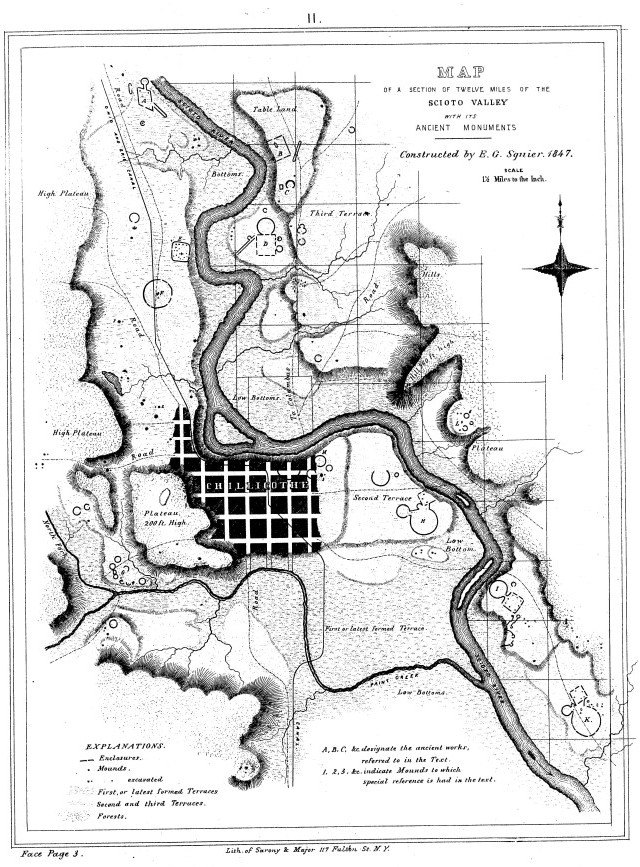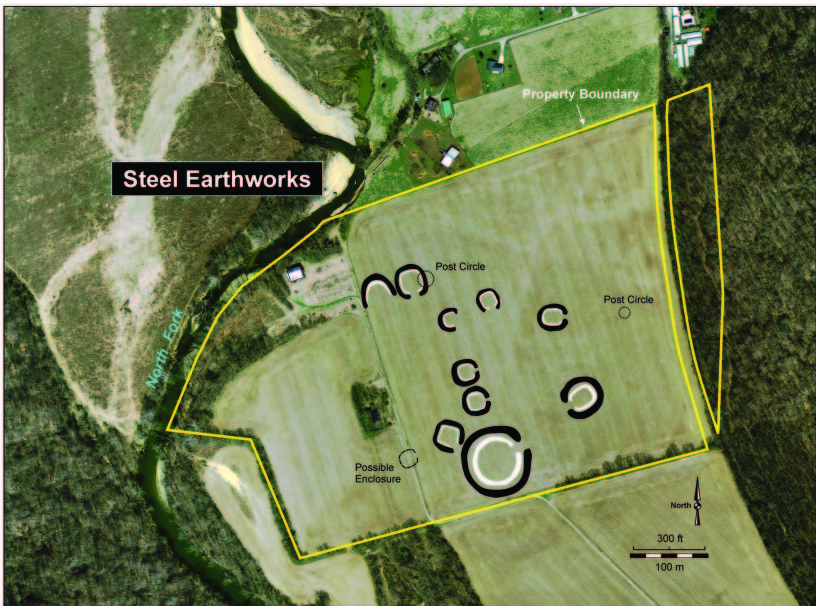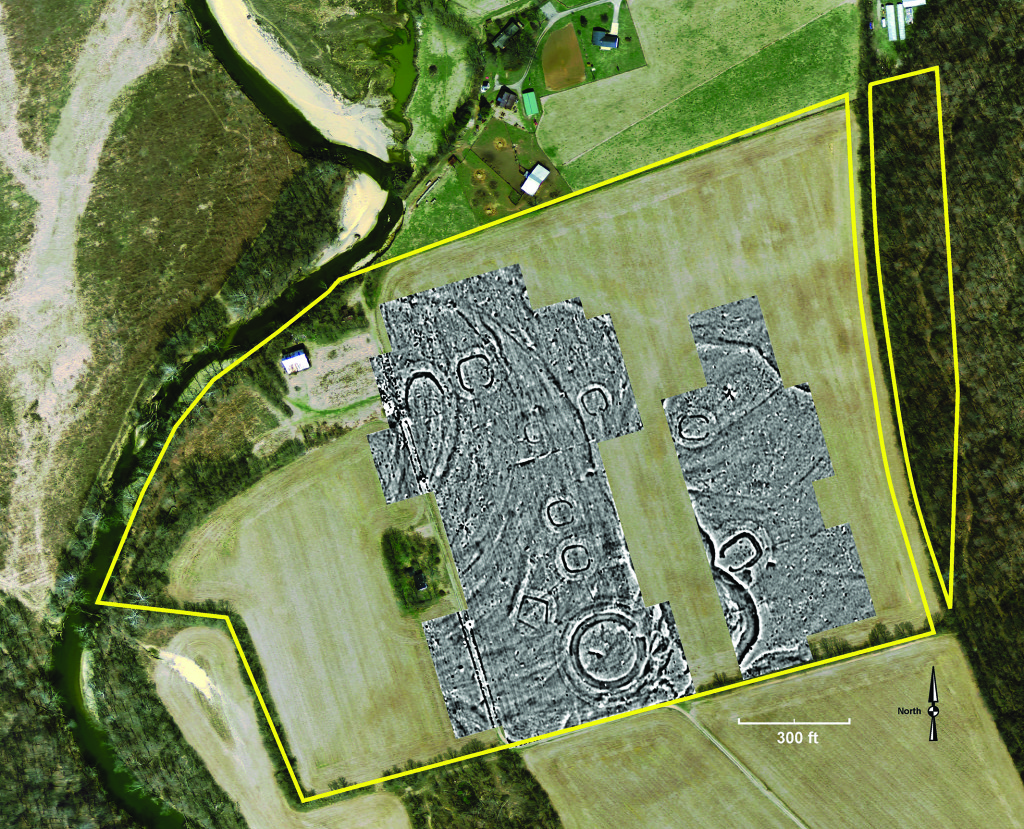Summer 2015
The Conservancy is working to acquire the Steel Earthworks, its sixth large Hopewell preserve in south-central Ohio, the heartland of the Hopewell culture. From about 100 B.C. to A.D. 500, the Hopewell produced massive earthworks. In addition to the burial mounds that characterized earlier time periods, they constructed geometric earthworks, some of which enclosed over a hundred acres within miles-long walls and featured astronomical alignments.
Extensive earthworks with walls extending for miles and enclosing hundreds of acres are the legacy of the Hopewell culture. They used shoulder blades of deer, split elk antler, clamshell hoes and digging sticks to collect soil, and then moved the soil in baskets holding 35 to 40 pounds. Some earthworks may have required a million basket-loads to complete.
They also procured an array of exotic raw materials from across North America, including grizzly bear teeth from the Rocky Mountains, obsidian from Idaho, mica from North Carolina, copper from the Upper Peninsula of Michigan, and whelk shells from the Gulf of Mexico. They fashioned these materials into expertly crafted small objets d’art that they buried with their dead. It is not surprising that the archaeological remains of the Hopewell people were recognized by early students of North American prehistory as something beyond the ordinary.
Since the Conservancy was founded in 1980, preserving Hopewell sites has been a major priority. The typesite Hopewell Mounds Group was the Conservancy’s first acquisition in the Chillicothe area, followed by High Bank Earthworks, Henneberger Works, Spruce Hill Works, and Junction Group.
Unfortunately, many sites in this region have been destroyed by urban sprawl, and modern farming has destroyed the rest. As these earthworks become increasingly rare, the need to preserve the few remaining sites is vital to preserving our country’s past (You can help – Donate Now).
This site, the Steel Earthworks, is unusual in that one circular earthwork remains visible in spite of decades of plowing. It measures 300 feet in diameter with an interior ditch and earthen wall. Initially, the Conservancy focused its efforts on acquiring only the visible circle with a small buffer area totaling eight acres. We reached a handshake agreement to purchase the site in 2003, but the landowner passed away. Recently inspired by the Conservancy’s acquisition of the nearby Junction Group Earthworks, a complex of at least eight earthen enclosures on 20 acres of farmland, a daughter decided to sell the entire 81-acre farm to the Conservancy.

The Squier and Davis Map was published in 1848. The Steel Group is represented by the circle and semicircle at the left edge of the plate about 40% up from the bottom.
The acquisition was increased from eight to 81-acres due to a magnetometer survey of the property conducted in 2007 by archaeologist Dr. Jarrod Burks, similar to the recent survey one at the Junction Group Site. Dr. Burks discovered that in addition to the visible earthwork and another known from a 19th century map, there were nine more earthworks with no surface traces, making Steel the site with the highest concentration of small earthworks so far discovered in Ohio.
One of the earthworks on the site is not the typical blend of a square and circle, known as a “squircle,” but is instead shaped more like a diamond, a form that’s not seen in any other earthwork complex. As the site has only small, simple enclosures without the elaborate geometric architecture of some other nearby sites such as Hopewell or High Bank, Dr. Burks hypothesizes that it is transitional from the Adena to Hopewell cultures, making it “the perfect laboratory for studying the end of small earthworks and the path towards mega earthworks.”
Purchasing 81-acres of Ohio farmland in the immediate path of residential development is a daunting fund-raising challenge, but a worthy one. We hope to work with land preservation partners like those that helped with the purchase of the nearby Junction Group and Spruce Hill earthworks.
The Conservancy’s Preservation Fund is essential to the purchase and long-term protection of each and every one of our preserves. You can help with Your gift of $25, $50, $100 or more for the Preservation Fund, choose designation for Steel Earthworks, will make such a difference in our efforts to preserve what will be the Conservancy’s sixth largest Hopewell preserve in south-central Ohio.
Read more about Steel Earthworks in American Archaeology Vol. 19 No. 2, Summer 2015. American Archaeology is available on Newsstands and at Bookstores, Subscriptions are available by becoming a member of the Archaeological Conservancy with a $25 Donation.

Steel Earthworks has the highest concentration of small earthworks so far discovered in Ohio. The 81-acre site has ten earthworks, one of which remains visible despite decades of plowing. It measures 300 feet in diameter with an interior ditch and earthen wall. Remote sensing clearly shows ten ancient earthworks, even if plowing has obscured them on the surface. The site lies in the immediate path of residential development only 100 yards to the North.




